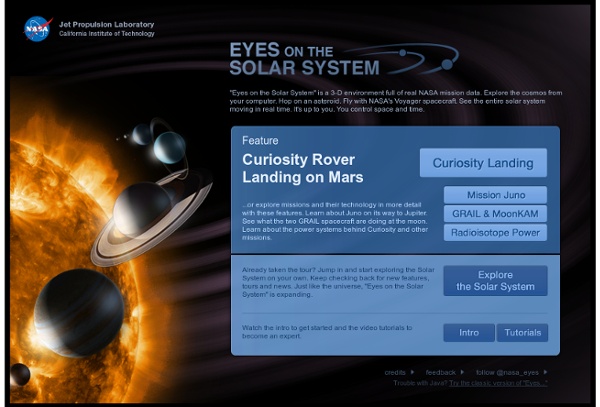



Field of Stars Brickstarter Exoplanets An interactive version of XKCD 1071: Exoplanets using data from Planetary Habilitability Laboratory (via @ProfAbelMendez) and adapted code from the d3.js Bubble Chart example (by @mbostock). Planets are drawn to scale using radius data. The dataset also includes attributes such as atmosphere type, which is included in the information area on the left. The dataset is large (about 1.1mb), so it may take a few seconds to load. All blue and light brown planets are smaller than Jupiter. Code can be found on github, and I can be found at @laneharrison. Special thanks to Drew Skau (@SeeingStructure) for help with the design details.
Online Dictionary Birth of the Moon | SpaceRip Posted by admin on Saturday, February 11, 2012 · The latest episode of Cosmic Journeys, enjoy in full HD 1080p. Scientists have been reconstructing the history of the moon by scouring its surface, mapping its mountains and craters, and probing its interior. Decades ago, we sent astronauts to the moon as a symbol of confidence in the face of the great cold war struggle. When the astronauts of Apollo stepped out of their landing craft, they entered a world draped in fine sticky dust, strewn with rocks, and pocked with craters. Back in earth-bound labs, scientists went to work probing the rocks for clues to one of the most vexing questions in all of science. The nature of the moon began to come into focus four centuries ago. What was the nature of the heavens, and how did the world of men fit within it? To some philosophers, the moon was a perfect, crystalline sphere of divine substance, free of Earth’s imperfections.
Today's Tomorrow My bag choice for mirror-less cameras, or small DSLR kit (24-70mm and 50mm) has been the Think Tank Retrospective 5 since 2011. Small bag, really comfortable to wear, a big fan. Think Tank recently announced the new Urban Approach series and it got my attention… Will this replace my beloved Retro 5? For my shooting style here’s my take on the two… PROS:-A more refined design… Less things I don’t need/use…. CONS:-I’m so use to the RETRO 5 that it feels like a second skin, The URBAN 5 feels little stiff in comparison. PROS:-Soft canvas style fabric-Slightly bigger then the URBAN 5-Great strap-After 4+ years of use it still looks and functions great. CONS:-Some complain about the accessories storage being on the inside but that never really bothered me. CONCLUSION:I don’t think I will stop using the RETRO 5, but the URBAN APPROACH 5 has some great features missing from the RETROSPECTIVE 5 that I have grown to really love.
Otkriven „groteskni“ brat blizanac Sunčevog sistema - National Geographic Srbija Sistem GJ676A je mnogo veći od našeg, ali mu veoma nalikuje, kažu astronomi… Astronomi su uočili našeg, kako kažu „grotesknog“ blizanca: planetarni sistem organizovan vrlo slično kao Sunčev sistem, otkriva se u novoj studiji. Nazvan GJ676A, sistem je koji ma dve kamenite planete koje orbitiraju u blizini zvezde i dva gasovita giganta koja su udaljena. I drugi sistemi koji se sastoje od više planeta su otkriveni do sada, poput onog nazvanog HD10180, koji se smatra najbogatijim egzoplanetarnim otkrićem jer ima sedam do devet planeta koje orbitiraju oko zvezde. „U sistemu GJ676A ima i kamenitih i gasovitih planeta – dok je njegovoj varijanta našeg Neptuna potrebno 4.000 dana da obiđe krug oko zvezde“, kaže vođa studije Giljem Anglada Eskude, postdoktorant na univerzitetu Gotingem u Nemačkoj. Dugačke orbite gasovitih giganata i kratke orbite ekstremno toplih super Zemlji su ono što je navelo astronome da nazovu GJ676A bratom blizancem našeg Solarnog sistema. Izvor: National Geographic News
Examples Of Myers Briggs Personalities In Stories Whatever one may say about the applicability of the Myers-Briggs indicator in Real Life, it is a valuable tool for stories. So what are some examples of characters that fit these profiles? Remember, since most of these characters are not canonically classified as one of these types, these are highly unofficial and subjective. This list is really made of the best guesses of lots of fans. Myers-Briggs types consist of four letters that represent different 'sides,' if you will. The different letters are: E or I for Extroverted or Introverted (whether a person thrives on human contact or private time); S or N for Sensing or Intuition (tendency to focus on immediate factual information vs. forming patterns and impressions); F or T for Feeling or Thinking (subjectivity vs. objectivity, or decisions based on feelings vs. facts); J or P for Judging or Perceiving ("orientation to the outer world," or a lifestyle that is structured and decided vs. one that is flexible and adaptable). .
Windows to the Universe Hubble Wallpaper Videos See the universe come to life via animations, scientific visualizations, expert commentary, and more. Solar System Scope OpenBitTorrent - An open tracker project